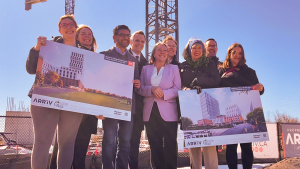Houston-based Occidental Petroleum Corp. announced an innovative carbon capture project in late August that could bring the state’s energy sector towards carbon neutrality.
The company said detailed engineering and early site construction has begun on a large-scale Direct Air Capture (DAC) plant in Ector County in partnership with 1PointFive, an Occidental subsidiary described as a “climate solution company.”
The first stage of construction is scheduled to begin later this year, with an operational start-up in late 2024. Australian firm Worley has been selected as the frontend design and engineering contractor.
Origis Energy of Miami will provide solar power to the project. Many other partners are expected to join as the project progresses. The DAC facility will involve up to 1,000 construction workers and will employ up to 75 full time workers when completed.
“Once operational, the plant is expected to capture up to 500,000 metric tons of carbon dioxide per year with the capability to scale up to one million metric tons per year,” the company said.
Occidental will use technology developed by Canadian company Carbon Engineering, located in Squamish B.C.
“Carbon Engineering has been innovating for more than a decade to deliver climate solutions at megaton scale,” said Daniel Friedmann, CEO of Carbon Engineering. “Now, with construction starting on this first, large-scale facility, we are seeing our vision become a reality. In collaboration with our partners at 1PointFive and Oxy, today marks a pivotal moment in the deployment of Carbon Engineering’s large-scale Direct Air Capture solutions.”
The captured CO2 will be processed into an industrial gas that could be used for enhanced energy extraction by Occidental, what is commonly referred to as “fracking.” The processed CO2 would therefore be sequestered deep in the ground to keep it out of the atmosphere.
“Construction of this transformative facility begins our journey toward providing commercial-scale DAC solutions that reduce and remove carbon emissions,” said Richard Jackson, president of U.S. onshore resources and carbon management, operations with Oxy. “This plant’s development is rooted in our carbon management expertise, strong record of delivering major projects and existing infrastructure that supports the commercialization of carbon capture, utilization and storage technologies. This plant could also anchor future low carbon projects and strengthen our portfolio of carbon management solutions.”
As described by Congressional Research Services (CRS), carbon capture technologies reduce the amount of carbon dioxide into the atmosphere. There are two technologies in development, the service explains.
The best known is Carbon Capture and Storage, which captures CO2 emissions at their source prior to release into the atmosphere. It is then compressed and transferred by pipeline for either storage underground or reprocessed for further upstream industrial applications.
The other is DAC. Air is forced over a chemical that can “grab” carbon dioxide right out of the atmosphere, even if emitted years before. These facilities can be installed anywhere.
The CRS expects many stakeholders will consider these two carbon capture techniques as a way to enable the continued use of fossil fuels, even if CO2 emissions were restricted in the United States and abroad.
This will be the first commercial application of DAC technology in the United States. The project has received $50 million of support under Chapter 313 of the Texas Tax Code, granted by the Ector County Independent School District. The company expects more incentives to come its way via the new federal Inflation Reduction Act.
The West Texas Basin is the largest petroleum-producing region in the United States, according to Todd Staple, president of the Texas Oil and Gas Association, and remains the backbone of the Texas economy.
However, fracking using a mix of water, sand and chemicals to enhance extraction has been environmentally controversial almost everywhere it has been used. As explained by MIT’s Climate Portal, under certain conditions the fracking mixture can flow back up the wells, potentially contaminating local water supplies. An uptick in seismic activity has also been reported in the West Texas Basin, which some seismologists blame on increased fracking.
However, using CO2 as an agent for fracking could provide certain public relations advantages as well as environmental cover for Occidental and the entire energy sector in Texas.
As outlined in the March 2020 issue of the International Journal of Hydrogen Energy, “Fracking with carbon dioxide instead of water allows carbon to be sequestered, leading to carbon savings equal to 60 nuclear plants or one billion solar panels.”











Recent Comments
comments for this post are closed